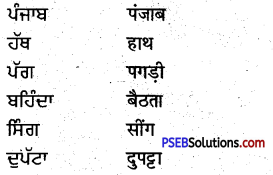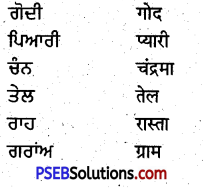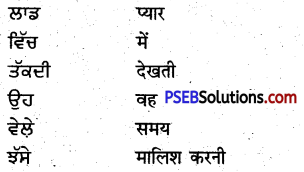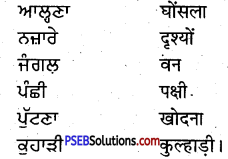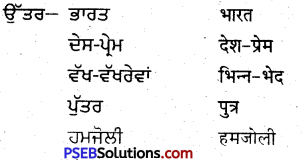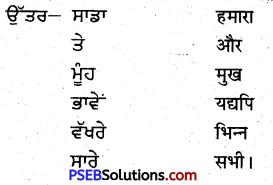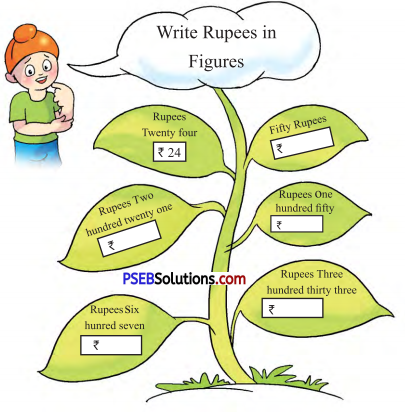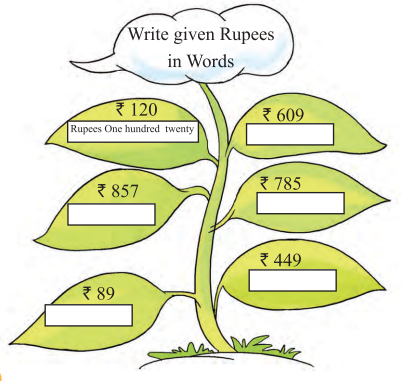Punjab State Board PSEB 5th Class Punjabi Book Solutions Chapter 6 ਕੌਮ ਦੀ ਸੇਵਾਦਾਰ Textbook Exercise Questions and Answers.
PSEB Solutions for Class 5 Punjabi Chapter 6 ਕੌਮ ਦੀ ਸੇਵਾਦਾਰ
1. ਦੱਸੋ:
ਪ੍ਰਸ਼ਨ 1.
ਵਾਰਡ ਵਿਚ ਨਰਸ ਦੇ ਆਉਣ ਨਾਲ ਰੋਗੀ ਨੂੰ ਕੀ ਮਹਿਸੂਸ ਹੁੰਦਾ ਹੈ ?
ਉੱਤਰ:
ਵਾਰਡ ਵਿਚ ਨਰਸ ਦੇ ਆਉਣ ਨਾਲ ਰੋਗੀ ਨੂੰ ਢਾਰਸੇ ਮਿਲ ਜਾਂਦੀ ਹੈ । ਉਸਨੂੰ ਮਹਿਸੂਸ ਹੁੰਦਾ ਹੈ ਕਿ ਕੋਈ ਉਸਦੀ ਦੇਖ-ਭਾਲ ਕਰਨ ਵਾਲਾ ਆ ਗਿਆ ਹੈ । ਉਸਦੀ ਮਿੱਠੀ ਮੁਸਕਾਣ ਨਾਲ ਰੋਗੀ ਸਾਰਾ ਦੁੱਖ ਭੁੱਲ ਜਾਂਦੇ ਹਨ ।
ਪ੍ਰਸ਼ਨ 2.
ਵਾਰਡ ਵਿਚ ਨਰਸ ਕੀ ਕੁੱਝ ਕਰਦੀ ਹੈ ?
ਉੱਤਰ:
ਨਰਸ ਵਾਰਡ ਵਿਚ ਆ ਕੇ ਕਿਸੇ ਰੋਗੀ ਨੂੰ ਥਰਮਾਮੀਟਰ ਲਾਉਂਦੀ ਹੈ ਤੇ ਕਿਸੇ ਦੀ ਨਬਜ਼ ਫੜ ਕੇ ਉਸ਼ਦਾ ਹਾਲ-ਚਾਲ ਪੁੱਛਦੀ ਹੈ । ਕਿਸੇ ਰੋਗੀ ਦੇ ਉਹ ਟੀਕਾ ਲਾਉਂਦੀ ਹੈ ਤੇ ਕਿਸੇ ਨੂੰ ਦਵਾਈ ਪਿਲਾਉਂਦੀ ਹੈ ਅਜਿਹਾ ਕਰਦੀ ਹੋਈ ਉਹ ਪ੍ਰੇਮ ਨਾਲ ਅਗਲੇ ਦਾ ਹਾਲ ਪੁੱਛਦੀ ਹੈ ।
2. ਖ਼ਾਲੀ ਥਾਂਵਾਂ ਭਰੋ :
(ੳ) ਜਿਉਂ ਤਿਤਲੀ ਦੀ ਹੋਏ ਉਡਾਣ, ਵੰਡਦੀ ਫਿਰਦੀ ਤਿਉਂ …………..।
(ਅ) ਰੋਗੀਆਂ ਤਾਈਂ ਮਿਲ ਗਈ ………..।
(ਇ) ਮਾਂ ਦੇ ਵਾਂਗਰ ਰੱਖਦੀ …………… !
(ਸ) ਆਪਣ ………… ਕਰਦੀ ਕੁਰਬਾਨ ਹੀ ਇਹ ਹੈ …………. ਸੇਵਾਦਾਰ ।
(ਕ) ਰੱਬ ਨੇ ਭੇਜੀ ਜੱਗ ‘ਤੇ ………।
ਉੱਤਰ:
(ਉ) ਜਿਉਂ ਤਿਤਲੀ ਦੀ ਹੋਏ ਉਡਾਣ, ਵੰਡਦੀ ਫਿਰਦੀ ਤਿਉਂ ਮੁਸਕਾਣ।
(ਅ) ਰੋਗੀਆਂ ਤਾਈਂ ਮਿਲ ਗਈ ਢਾਰਸ ।’
(ਇ) ਮਾਂ ਦੇ ਵਾਂਗਰ ਰੱਖਦੀ ਧਿਆਨ ।
(ਸ) ਆਪਣਾ ਸੁਖ ਕਰਦੀ ਕੁਰਬਾਨ ।
(ਹ) ਇਹ ਹੈ ਕੌਮ ਦੀ ਸੇਵਾਦਾਰ ।
(ਕ) ਰੱਬ ਨੇ ਭੇਜੀ ਜੱਗ ‘ਤੇ ਨਰਸ ।
![]()
3. ਸੰਖੇਪ ਵਿੱਚ ਉੱਤਰ ਦਿਓ:
ਪ੍ਰਸ਼ਨ 1.
ਇਸ ਕਵਿਤਾ ਵਿਚ ਕੌਮ ਦੀ ਸੇਵਾਦਾਰ ਕਿਸ ਨੂੰ ਕਿਹਾ ਗਿਆ ਹੈ ?
ਉੱਤਰ:
ਨਰਸ ਨੂੰ ।
ਪ੍ਰਸ਼ਨ 2.
ਨਰਸ ਵੇਖ ਕੇ ਕਿਸ ਨੂੰ ਸਾਰਾ ਦੁੱਖ ਭੁੱਲ ਜਾਂਦਾ ਹੈ ?
ਉੱਤਰ:
ਰੋਗੀਆਂ ਨੂੰ ।
ਪ੍ਰਸ਼ਨ 3.
ਨਰਸ ਮਰੀਜ਼ਾਂ ਦਾ ਧਿਆਨ ਕਿਸ ਵਾਂਗਰ ਰੱਖਦੀ ਹੈ ?
ਉੱਤਰ:
ਮਾਂ ਵਾਂਗਰ ।
4. ਹੇਠ ਲਿਖੇ ਸ਼ਬਦਾਂ ਨੂੰ ਵਾਕਾਂ ਵਿੱਚ ਵਰਤੋ:
ਹੇਠ ਲਿਖੇ ਸ਼ਬਦਾਂ ਨੂੰ ਵਾਕਾਂ ਵਿਚ ਵਰਤੋ ਮਰੀਜ਼, ਥਰਮਾਮੀਟਰ, ਨਵੀਂ-ਨਕੋਰ, ਸੇਵਾਦਾਰ, ਤਰਸ ।
ਉੱਤਰ:
- ਮਰੀਜ਼ (ਰੋਗੀ)-ਹਸਪਤਾਲ ਵਿਚ ਬਹੁਤ ਸਾਰੇ ਮਰੀਜ਼ ਦਾਖ਼ਲ ਹਨ ।
- ਥਰਮਾਮੀਟਰ ਰੋਗੀ ਦੇ ਸਰੀਰਕ ਤਾਪ ਨੂੰ ਮਾਪਣ ਦਾ ਯੰਤਰ)-ਰੋਗੀ ਨੂੰ ਥਰਮਾਮੀਟਰ ਲਾਓ ਤੇ ਦੇਖੋ ਉਸਨੂੰ ਕਿੰਨਾ ਬੁਖ਼ਾਰ ਹੈ ।
- ਨਵੀਂ-ਨਕੋਰ (ਬਿਲਕੁਲ ਨਵੀਂ-ਅੱਜ ਤਿਉਂਹਾਰ ਦੇ ਦਿਨ ‘ਤੇ ਮੈਂ ਨਵੀਂ-ਨਕੋਰ ਕਮੀਜ਼ ਪਾਈ ।
- ਸੇਵਾਦਾਰ ਸੇਵਾ ਕਰਨ ਵਾਲਾ)-ਮੈਂ ਤਾਂ ਤੁਹਾਡਾ ਸੇਵਾਦਾਰ ਹਾਂ, ਜੋ ਕਹੋਗੇ, ਮੈਂ ਕਰਾਂਗਾ ।
- ਤਰਸ (ਦਇਆ-ਦੁਖੀਆਂ-ਗ਼ਰੀਬਾਂ ਉੱਤੇ ਤਰਸ ਕਰੋ
5. ਹੇਠਾਂ ਗੁਰਮੁਖੀ ਅਤੇ ਦੇਵਨਾਗਰੀ ਵਿੱਚ ਸ਼ਬਦ ਦਿੱਤੇ ਗਏ ਹਨ। ਇਹਨਾਂ ਸ਼ਬਦ-ਜੋੜਾਂ ਦੇ ਅੰਤਰ ਨੂੰ ਸਮਝੋ ਅਤੇ ਗੁਰਮੁਖੀਵਿੱਚਦਿੱਤੇ ਸ਼ਬਦਾਂ ਨੂੰ ਲਿਖਣ ਦਾ ਅਭਿਆਸ ਕਰੋ:
ਹੇਠਾਂ ਗੁਰਮੁਖੀ ਵਿਚ ਦਿੱਤੇ ਸ਼ਬਦਾਂ ਦੇ ਦੇਵਨਾਗਰੀ ਰੂਪ ਲਿਖੋ
ਧਿਆਨ, ਪਛਾਣ, ਬਸਤਰ, ਪੁੱਛਦੀ, ਹੱਸ ਕੇ, ‘ ਕੀ, ਪਿਆਰ, ਵੰਡਦੀ ।
ਉੱਤਰ:

6. ਹੇਠਾਂ ਇੱਕ ਹੀ ਅਰਥ ਲਈ ਪੰਜਾਬੀ ਅਤੇ ਹਿੰਦੀ ਵਿੱਚ ਭਿੰਨ-ਭਿੰਨ ਸ਼ਬਦ ਹਨ।ਇਹਨਾਂ ਨੂੰ ਧਿਆਨ ਨਾਲ ਪੜੋ ਅਤੇ ਪੰਜਾਬੀ ਦੇ ਸ਼ਬਦਾਂ ਨੂੰ ਲਿਖਣ ਦਾ ਅਭਿਆਸ ਕਰੋ
ਹੇਠਾਂ ਦਿੱਤੇ ਪੰਜਾਬੀ ਦੇ ਸ਼ਬਦਾਂ ਦੇ ਸਮਾਨਾਰਥੀ ਹਿੰਦੀ ਸ਼ਬਦ ਲਿਖੋ-
ਅਰਸ਼, ਤੋਰ, ਢਾਰਸ, ਤੱਕ ਕੇ, ਨਾਲ, ਦੱਸੋ, ਹੁਣ ।
ਉੱਤਰ:
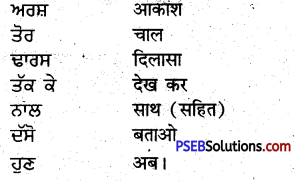
![]()
7. ਕਾਵਿ-ਟੋਟਿਆਂ ਦੇ ਸਰਲ ਅਰਥ
(ੳ) ਉਜਲੇ ਚਿੱਟੇ ………….,,,,,,,, ਤਿਉਂ ਮੁਸਕਾਣ ।
ਸਰਲ ਅਰਥ-ਕਵੀ ਕਹਿੰਦਾ ਹੈ ਕਿ ਹਸਪਤਾਲ ਵਿਚ ਨਰਸ ਇਸ ਤਰ੍ਹਾਂ ਜਾਪਦੀ ਹੈ, ਜਿਸ ਤਰ੍ਹਾਂ ਸਾਫ਼ਸੁਥਰੇ ਚਿੱਟੇ ਕੱਪੜੇ ਪਾ ਕੇ ਅਸਮਾਨ ਤੋਂ ਕੋਈ ਪਰੀ ਆਈ ਹੋਵੇ । ਉਹ ਹਰ ਵੇਲੇ ਤਾਜ਼ਾ ਦੰਮ ਤੇ ਨਵੀਂ ਨਕੋਰ ਦਿਸਦੀ ਹੈ । ਉਸ ਦੀ ਤੋਰ ਵਿਚ ਬੜੀ ਚੁਸਤੀ ਹੈ । ਇਸ ਤਰ੍ਹਾਂ ਜਾਪਦਾ ਹੈ, ਜਿਵੇਂ ਕੋਈ ਤਿਤਲੀ ਉੱਡ ਰਹੀ ਹੋਵੇ । ਉਹ ਹਸਪਤਾਲ ਵਿਚ ਹਰ ਥਾਂ ਮੁਸਕਰਾਹਟਾਂ ਵੰਡਦੀ ਫਿਰਦੀ ਹੈ ।
(ਅ) ਵਾਰਡ ਅੰਦਰ ………………………. ਪੁੱਛ ਪੁਛਾਂਦੀ ।
ਸਰਲ ਅਰਥ-ਕਵੀ ਕਹਿੰਦਾ ਹੈ ਕਿ ਨਰਸ ਜਦੋਂ ਵਾਰਡ ਵਿਚ ਆਉਂਦੀ ਹੈ, ਤਾਂ ਉਹ ਇਕ ਦਮ ਰੌਣਕ ਲਾ ਦਿੰਦੀ ਹੈ । ਉਸ ਦੇ ਆਉਣ ਨਾਲ ਰੋਗੀਆਂ ਨੂੰ ਹੌਸਲਾ ਮਿਲਦਾ ਹੈ । ਉਨ੍ਹਾਂ ਨੂੰ ਜਾਪਦਾ ਹੈ ਕਿ ਉਨ੍ਹਾਂ ਦੀ ਸੰਭਾਲ ਕਰਨ ਵਾਲਾ ਕੋਈ ਮਾਲਕ ਆ ਗਿਆ
ਹੈ । ਉਹ ਕਿਸੇ ਨੂੰ ਤਾਂ ਥਰਮਾਮੀਟਰ ਲਾਉਂਦੀ ਹੈ ਤੇ ਕਿਸੇ ਦੀ ਨਬਜ਼ ਫੜ ਕੇ ਹਾਲ-ਚਾਲ ਪੁੱਛਦੀ ਹੈ ।
(ਇ). ਕਿਸੇ ਨੂੰ ਹੱਸ……………………… ਭੁੱਲ ਜਾਣ !
ਸਰਲ ਅਰਥ-ਕਵੀ ਕਹਿੰਦਾ ਹੈ ਕਿ ਨੇਰਸ ਵਾਰਡ ਵਿਚ ਆ ਕੇ ਕਿਸੇ ਰੋਗੀ ਨੂੰ ਹੱਸ ਕੇ ਟੀਕਾ ਲਾਉਂਦੀ ਹੈ ਤੇ ਕਿਸੇ ਨੂੰ ਦਵਾਈ ਪਿਲਾਉਂਦੀ ਹੈ । ਉਹ ਸਾਰਿਆਂ ਨੂੰ ਬੜੇ ਪ੍ਰੇਮ ਤੇ ਪਿਆਰ ਨਾਲ ਪੁੱਛਦੀ ਹੈ ਕਿ ਉਨ੍ਹਾਂ ਦਾ ਹਾਲ-ਚਾਲ ਕੀ ਹੈ ।ਉਸ ਦੀ ਮਿੱਠੀ ਮੁਸਕਰਾਹਟ ਦੇਖ ਕੇ ਰੋਗੀ ਸਾਰਾ ਦੁੱਖ ਭੁੱਲ ਜਾਂਦੇ ਹਨ ।
ਸ) ਬੋਲੇ ਜਦ ਇਹ………………………….. ਕਰਦੀ ਕੁਰਬਾਨ ।
ਸਰਲ ਅਰਥ-ਵਾਰਡ ਵਿਚ ਆਈ ਨਰਸ ਜਦੋਂ ਪਿਆਰ ਨਾਲ ਬੋਲਦੀ ਹੈ, ਤਾਂ ਰੋਗੀ ਨੂੰ ਬਹੁਤ ਖੁਸ਼ੀ ਹੁੰਦੀ ਹੈ । ਉਹ ਆਪਣਾ ਸੁਖੁ ਕੁਰਬਾਨ ਕਰ ਕੇ ਰੋਗੀ ਦਾਮਾਂ ਵਾਂਗ ਖ਼ਿਆਲ ਰੱਖਦੀ ਹੈ । …
(ਹ) ਹੁਣ ਤੁਸਾਂ ਹੈ …………. ’ਤੇ ‘ਨਰਸ’
ਸਰਲ ਅਰਥ-ਕਵੀ ਕਹਿੰਦਾ ਹੈ ਕਿ ਉਸ ਦੀ ਕਵਿਤਾ ਪੜ੍ਹਦਿਆਂ ਹੁਣ ਪਾਠਕਾਂ ਨੇ ਸਮਝ ਲਿਆ ਹੋਵੇਗਾ ਕਿ ਰੋਗੀਆਂ ਦੀ ਜ਼ਿੰਦਗੀ ਕੌਣ ਹੈ । ਇਹ ਕੌਮ ਦੀ ਸੇਵਾਦਾਰ ਨਰਸ ਹੈ, ਜਿਸ ਨੂੰ ਰੋਗੀ ਪਿਆਰ ਕਰਦੇ ਹਨ ਅਸਲ ਵਿਚ ਰੱਬ ਨੇ ਰੋਗੀਆਂ ਲਈ ਤਰਸ ਕਰ ਕੇ ਦੁਨੀਆ ਉੱਤੇ ਨਰਸ ਭੇਜੀ ਹੈ ।
8. ਬਹੁਵਿਕਲਪੀ ਪ੍ਰਸ਼ਨ
ਹੇਠ ਦਿੱਤੇ ਪ੍ਰਸ਼ਨਾਂ ਦੇ ਬਹੁਵਿਕਲਪੀ ਉੱਤਰਾਂ ਵਿੱਚੋਂ ਠੀਕ ਉੱਤਰ ਅੱਗੇ ਸਹੀ (✓) ਦਾ ਨਿਸ਼ਾਨ ਲਾਓ
ਪ੍ਰਸ਼ਨ 1:
ਕੌਮ ਦੀ ਸੇਵਾਦਾਰ ਕਵਿਤਾ ਕਿਸ ਦੀ ਲਿਖੀ ਹੋਈ ਹੈ ?
ਉੱਤਰ:
ਧਨਵੰਤ ਸਿੰਘ ਸ਼ੀਤਲ (✓) ।
ਪ੍ਰਸ਼ਨ 2.
‘ਕੌਮ ਦੀ ਸੇਵਾਦਾਰ ਕਿਸ ਨੂੰ ਕਿਹਾ ਗਿਆ ਹੈ ?
ਉੱਤਰ:
ਨਰਸ ਨੂੰ ਆ ।
ਪ੍ਰਸ਼ਨ 3.
ਨਰਸ ਦੇ ਕੱਪੜੇ (ਬਸਤਰ) ਕਿਹੋ-ਜਿਹੇ ਹੁੰਦੇ ਹਨ ? :
ਉੱਤਰ:
ਉਜਲੇ ਚਿੱਟੇ (✓) ।
ਪ੍ਰਸ਼ਨ 4.
ਉਜਲੇ ਚਿੱਟੇ ਕੱਪੜਿਆਂ ਵਿਚ ਨਰਸ ਕੀ ਜਾਪਦੀ ਹੈ ?
ਉੱਤਰ:
ਅਸਮਾਨੀ ਪਰੀ (✓) ।
![]()
ਪ੍ਰਸ਼ਨ 5.
ਕਿਸਦੀ ਉਡਾਣ ਤਿਤਲੀ ਵਰਗੀ ਜਾਪਦੀ ਹੈ ?
ਜਾਂ
ਕੌਣ ਹਰਦਮ ਚੁਸਤ ਫੁਰਤ ਤੇ ਨਵੀਂ ਨਕੋਰ ਜਾਪਦੀ ਹੈ ?
ਜਾਂ ‘
ਕੌਣ ਵਾਰਡਾਂ ਵਿਚ ਮੁਸਕਾਨ ਵੰਡਦੀ ਤੇ ਰੌਣਕ ਲਾ, ਦਿੰਦੀ ਹੈ ?
ਜਾਂ
ਰੋਗੀਆਂ ਨੂੰ ਕਿਸ ਤੋਂ ਢਾਰਸ ਮਿਲਦੀ ਹੈ ?
ਜਾਂ
ਕੌਣ ਰੋਗੀਆਂ ਨੂੰ ਪ੍ਰੇਮ ਨਾਲ ਉਨ੍ਹਾਂ ਦਾ ਹਾਲ ਪੁੱਛਦੀ
ਜਾਂ
ਕੌਣ ਰੋਗੀਆਂ ਦੀ ਨਬਜ਼ ਫੜਦੀ, ਥਰਮਾਮੀਟਰ ਤੇ ਟੀਕੇ ਲਾਉਂਦੀ ਹੈ ?
ਜਾਂ
ਕਿਸਦੀ ਮਿੱਠੀ ਮੁਸਕਾਨ ਨਾਲ ਰੋਗੀ ਦੁੱਖ ਭੁੱਲ ਜਾਂਦੇ ਹਨ ।
ਜਾਂ
ਕੌਣ ਆਪਣਾ ਸੁਖ ਛੱਡ ਕੇ ਮਾਂ ਵਾਂਗ ਰੋਗੀਆਂ ਦਾ ਧਿਆਨ ਰੱਖਦੀ ਹੈ ?
ਜਾਂ
ਰੱਬ ਨੇ ਦਿਲ ਵਿਚ ਤਰਸ ਕਰ ਕੇ ਦੁਨੀਆ ਉੱਤੇ ਕੀ ਭੇਜਿਆ ਹੈ ?
ਉੱਤਰ:
ਨਰਸ (✓) ।
ਪ੍ਰਸ਼ਨ 6.
‘ਜਿਉਂ-ਤਿਤਲੀ ਦੀ ਹੋਏ ਉਡਾਣ, ਵੰਡਦੀ ਫਿਰਦੀ ਤਿਉਂ …. ‘ ਖ਼ਾਲੀ ਥਾਂ ਲਈ ਢੁੱਕਵਾਂ ਸ਼ਬਦ ਕਿਹੜਾ ਹੈ ?
ਉੱਤਰ:
ਮੁਸਕਾਨ (✓) ।

